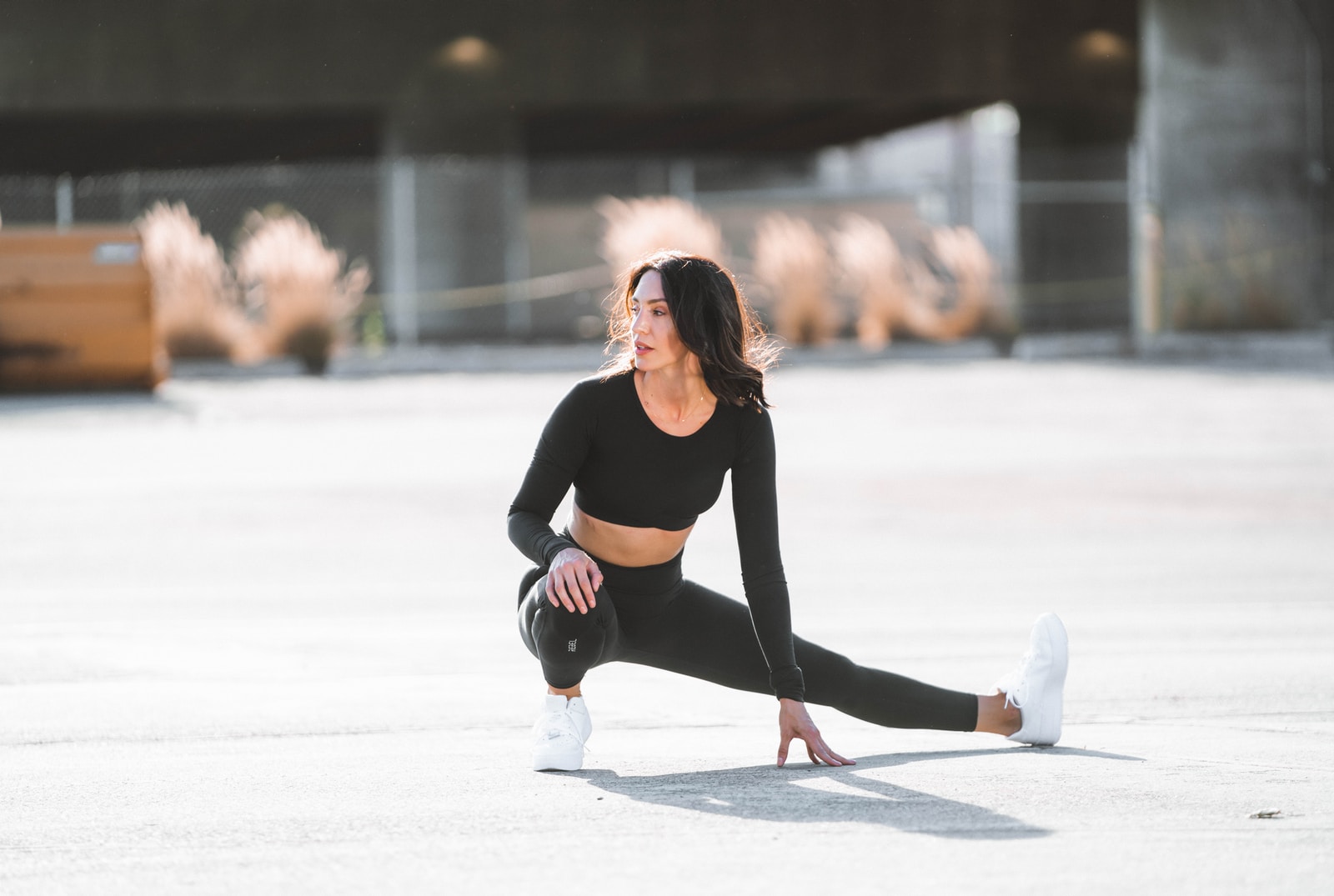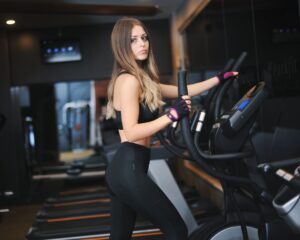The time we spend even making time to workout is precious. So you don’t want to waste your time. I combed the internet and consulted with Neda Khalili, a veteran Equinox trainer, to get you the complete guide. You can find all of the videos in the DAOFitLife playlist if you want to watch them after reading the article.
*Peer reviewed and co-authored by Neda Khalili, NASM certified trainer
Start with what’s happening when you are not working out
Nutrition -like in this and this post, nutrition is responsible for over 80 percent of the equation. Calories working out only are responsible for FIVE PERCENT of our total energy expenditure. If you are just starting a path to fitness, focus on diet alone for a few weeks before incorporating a lot of exercise. Otherwise you will just be overwhelmed. In fact, if I reach a plateau or a point where I have tighter clothes, I purposely take a break from working out because that means I need to refocus on my diet.
Here’s a useful video to watch by Dr. Mike (one of my favorite channels on YouTube), where he explains some of the top beginner mistakes. One of them is thinking exercise is the end all be all – as we reviewed last week, this is one of the biggest myths. Like Dr. Mike says, you can’t focus on one Pillar and expect the pyramid to grow.
Put some effort into posture
With what we are doing most of the day, which is working, we could be doing severe damage to our spinal health, compromising any benefits we would have from an exercise regime. In grade school, we learn the song “the knee bone is connected to the– hip bone!” It is funny because, we are never taught that this song about connecting body parts will be so pertinent within our lives. Everything is connected and if one thing is out alignment, much like a math problem- things will automatically get more complicated. So if we are hunched our all day, sitting or standing- over our devices, our posture will suffer and create some serious complications when we go about our workout, especially in the forward motion (pushing)/concentric movements.
Here is where we must take it back to basics and focus on ergonomic lifestyle choices (whether be a standing desk/the right chair), take diligent effort towards foam rolling, lacrosse ball exercises as needed, and take posture breaks throughout the day (maybe 5 minutes to the end of every hour) and assess what our posture is like, doing some stretches to open up the chest and release the lats or take a walking break even.
Even while out walking, try this quick posture check in: Either sitting or standing, keep a neutral spine (not rigid or curved- just natural), take a deep breath and roll your shoulders up, back, and down, and then imagine that your shoulder blades are pressing a pencil together and release and repeat. While performing this, imagine, that your head is held held high and slightly pressed back and as you are lifting your shoulder blades, try not to let your neck scrunch with the exercise, keep yourself relaxed. Try this for a few minutes and see how you feel!
Put some time into prep
Your workout is like an important business meeting – you don’t just go in blind, you have an agenda and have done some prep. As part of that prep, having a pre-planned exercise sheet like this one can be helpful, because you know exactly what you are supposed to be doing. You can even program into your calendar to know exactly when. Have your workout clothes all lined up for the week, like this: Have your audio or visual queued up (music playlist, podcast, Youtube, streaming).
Nutrition is also key. We talked in this article about preworkout nutrition and how you can benefit from taking in some simple carbs even before an early morning workout.
Another highly recommended pregamer (scientifically backed) is caffeine. It’s not just for the extra energy. Caffeine is proven to reduce muscle soreness. What’s the right amount? About 3mg/kg of body weight. So if you are a 60kg female, that’s about 2 cups of coffee (sounds about right!)
If you aren’t a caffeine person, some peppermint tea can be a great choice to wake you up, or you can just rely on your pre-workout meal for energy. There are a number of pre-workouts on the market, but like Dr. Mike says in his video, coffee is just as good. You don’t necessarily need to go on a supplement shopping spree and buy chalky chemicals to have a good workout.
Warm up
Raise your hand if you have ever skipped a warm up because you are short on time (me!). Again, injury is a huge factor that warming up is there to counter. Even besides that, warming up can help you “get into the zone” and mentally activate yourself to have a better workout. Physically, it helps prime your body to receive more oxygen, thus making the workout more effective. It’s kind of like warming up a car for a few minutes before driving it. This may make sense only in super cold temps, but for our bodies the outside temperature is not as critical as what is going on in our blood cells and heart pumping activity. I have seen trainers who have had their clients come in very late but never skip warming up, this is because you want to be able to maximize all of your body to work for you and prevent injury. Sometimes one can ‘think’ their muscles are primed and ligaments and tendons are good to go because they were rushing on over- so their their muscles are warm, right?! Wrong. There is no better feeling than having a tenacious workout and feeling strong but not overtaken and with that unnatural sort of pull. Why not have that feeling more often than not and have your workout definitely work for you.
Warming up can be as basic as walking for a few minutes or some dynamic movement. Most trainers recommend saving static stretches until the end of the workout. Even if my workout is cardio, for example walking or jogging, I walk at a slower pace for just a few minutes instead of trying to charge it up to a high speed. I have literally seen people hop on a treadmill and crank it up to 7.0 in a straddle position and then jump on and go. That may make them feel good about themselves, but progressing to a top speed is much better for your body and for your heart. Even if you are doing a HIIT-based workout, 5 minutes at a moderate walking pace beforehand is a good idea. If you still aren’t convinced, then read this article about the importance of warming up .
Be “basic”
That’s rarely a positive reference, but in the context of weight training, people tend to get too ornamental without focusing on whether the exercise is actually training the desired area. Like Dr. Mike says in his video above, keeping it simple with some cardio and compound body movements, you do not need to do ridiculously complicated workouts with lots of bells and whistles. That’s the kind of belief that sells app downloads, but does not get results. Similarly to what I wrote about last week, form before function is key and supersedes it all.
Instead of thinking of the movement, think of the areas that you want to train, and consult a menu of basic movements like this one. If that’s too old-fashioned, then I would recommend an app like fitbod where you identify the areas of the body you want to train and the app puts together a routine.
Here are some basic move bodyweight staples. Not only are they basic and probably familiar to everyone but they also work in conjunction with the primary muscle group different sets of stabilizing muscles that fire up your core and upper / lower body.
- Deadbug
- Plank
- Push-up
- Jacknife or regular sit-up
- Air squats
- Bicycle crunches
- Donkey kicks
- Fire hydrants
- Bridges
You can do a bunch of variations with all of the above, including adding weights, bands, and exercise balls, but getting back to basics first and staying in good form would be more beneficial. Which brings us to the next section .
Get the form down before you up the reps or weights
After you have done your warmup, where you can really feel the extensibility of what your muscles can do, you want to break down each exercise and more or less, ‘be present’ with the exercise. For example, when doing an air squat, inspecting yourself in the mirror- asking yourself the questions: Is my spine arching or curving? Am I leading with my butt vs my back? Is my weight sinking into my heels? Are my knees caving inward or outward? Is my core taut to keep my spine protected? How are lats doing- are they holding everything pushed back? Do I have any pain the body (not the oh-so-ooooh burn but the “uhhh okay-ouch, is my body supposed to pinch that way),etc.
Taking the approach to move properly and to be diligently present with each rep is key to getting stronger, achieving the results you desire, and being in it and feeling good for the long run. It may seem like a lot, but bringing it back to basics and taking baby steps keeps consistency. Sooner than you know, with that consistency, you up the ante and mix it up, and still feel good for the long run!
Don’t complicate exercises, just tweak existing ones
Introduce instability
For example, a great warm up move is the bird dog, which is also good for the spine (involving starting on all fours and then raising one arm and the opposite leg). single lead deadlifts, or try standing one one leg while doing those bicep curls the next time. That forces you to further engage your core. Also, the isolation exercises on each leg introduce a sense of balance and force you not to rely on your dominant leg. You may not notice it with both feet on the ground, but most people have that tendency.
Vary your direction
Most people think on a front to back or vertical plane – which makes sense. We don’t walk sideways or backwards (although you see THAT person in the gym doing it occasionally.
Lateral squats, lunges, bandwalks and raises are good ways to start training your body to getting more accustomed to this movement.
Give equal time to what you can’t see in the mirror
Does anyone remember when Hilary Swank won the Oscar for Million Dollar Baby (how could she not have)? Getting more attention than the award was her marvelous navy dress that covered up past her collarbone in the front but was completely open showing off her gorgeous back. (PS, if you are into fashion, click the link for a gallery of Best Oscar Dresses of all time!!)
Commonly walking around the gym my editor Neda, who has trained clients at Equinox for 10 years, sees a lot of biceps and chest presses. You have to fight to get a squat rack, but the seated leg curl/ lying leg curl machine and the glute blaster are almost ornamental.
Training your back is more than aesthetics – training your back and your core is important for spine health. A healthy back (and entire backside of the body- aka the posterior chain) is key to a healthy life. Learning about retracting your shoulder blades and releasing your chest muscles will literally give your diaphragm more space to take in more oxygen and breath more easily. Spine health is key for the long run in preventing osteoporosis and also key in keeping everything in alignment so that you don’t have compensation issues that turn into injuries. The benefits of spine health are virtually endless, keep your back strong and turn your back on these trends!
Here’s a short video for some good back exercises. I picked up a few more ideas from it:
Cycle between hard and easy to allow time for recovery
As we talked about in this article, overtraining and under recovery can put you at the risk of injury and undermine results. If you bounce of the walls like I do, however, you can easily compromise by incorporating walking on your recovery days. This way you can avoid overtraining and under recovery.
If you go hard every day, you will inevitably notice that you willl get to muscle failure a lot more quickly and your workouts will not be as energized. It’s like topping off an already full gas tank – there’s no point, it’s just going to spillover and have no value.
Jillian Michaels talks about this in her video, below, and recommends not training intensely for more than 6 hours a week.
Stretching and foam rolling (not to be saved for “later”)
You finish your workout and need to dive in front of your computer for that 9am call. You figure, I will stretch later. NO NO NO. Not if you want to keep your body going and not end up injured. I learned this the hard way!
Build in at least 5-15 minutes to allow for a cool down stretch and foam roll, if you have that equipment at home or access to a gym. If I look at the typical profile of people who I see foam rolling at the gym, it’s the trainers themselves. That’s because foam rolling isn’t just a massage, it’s a workout.
The same goes for stretching. It’s a hallmark of an experienced trainer when I take a class and they start the stretch portion that lasts at least one song. Unfortunately many of us have been exposed to the practice of either workout apps or classes that have a few cursory stretches and send you on your way, reminding you to stretch “later.”
Making it a habit to incorporate important stretches including for the spine will seal the benefits of your workout and make sure you are limber for the rest of the day. I don’t end a workout without doing the following:
- Cobra
- Cat-cow
- Standing goalpost shoulder stretch
- Quad stretch and Figure four (a MUST for runners)
- Hamstring stretch (you can do this seated, standing, or even lying down)
- Lateral and overhead tricep arm stretch
- Neck stretch (super important as an everyday exercise)
Foam rolling is something I try to do at least once a week. They key with foam rolling is not to rush through in. In fact, pausing to do “triggerpoint” on the muscles especially with a specialized foam roller like this one can release deep knots and built up fluids.
Here is a 21-move stretching routine from Self Magazine and foam rolling routines.
Spread out your training
In this video with Jillian Michaels, she explains that separating muscle groups and push-pull movements is the way that she makes sure to train different muscle groups. She even trains her upper abs and lower abs in one session and then focuses on obliques the next session. For push movements, think squats, chest and triceps- for pull think biceps, back (including hamstrings, and glutes. She recommends not training a muscle group intensely more than twice a week.
Sample push workout with oblique work
Warm up as usual, foam roll the t-spine, lats, doing some chest stretches
Some Crocodile breathes to prime your core and get ready to utilize deep breathing throughout your routine
Shoot for 3 sets of 12-15 repetitions with body weight/ modified support or weight that suits you.
Routine
- Push Up
- Seated/Standing Dumbbell/ resistance band press
- Assisted Dip (either with the machine or bench)
- Static Side Planks (30-40 seconds/side)
- Slow Motion bicycle crunch (form before function!)
- Squats (Either Bodyweight or Machine or Barbell)
- Quadricep curls
- High Dynamic Skips
- Cooldown with some easy walking on the treadmill and perform some static stretches for your chest and for your quadriceps and glutes
Sample pull workout with front back abdomen work
Warm up as usual, foam roll the chest, triceps, and glutes and hamstrings
Some Crocodile breathes to prime your core and get ready to utilize deep breathing throughout your routine
Shoot for 3 sets of 12-15 repetitions with body weight/ modified support or weight that suits you.
- Lat Pulldown (with a band from a high anchor or a machine), focusing in on the squeeze between your shoulder blades before a slow release
- Assisted Pull Up Machine or actual Pull Up
- Standing straight arm pulldown (with a band or a machine) with a focus on keep your spine completely taut throughout (you will feel a pull in your low abs aka the transverse abdominus- this is a good thing!)
- Bridges
- Leg lowers for abs
- Deadlifts or Good Mornings, either with Weight or Bodyweight
- Hip Thrust (weighted or not)
- Cable/Resistance Band Pull Through
- Cooling down with easy cardio of choice and performing static stretches for the back, glutes, and hamstrings
You can also divide the training into upper body and lower body, as long as you separate each upper body and lower body workout by at least 48 hours. But remember, if you were doing an intense HIIT workout or a spin class, that is akin to a full body and leg workout, so build it the appropriate amount of recovery before training again. So if you do upper body on Monday, and a spin class Tuesday, a HIIT workout on Wednesday would probably not allow adequate time for recovery. Neda recommends the “rule of three” – hard, hard, then easy. So in that scenario, Wednesday would be a good walking day.
More resources:
Weight training mistakes (exrx)














